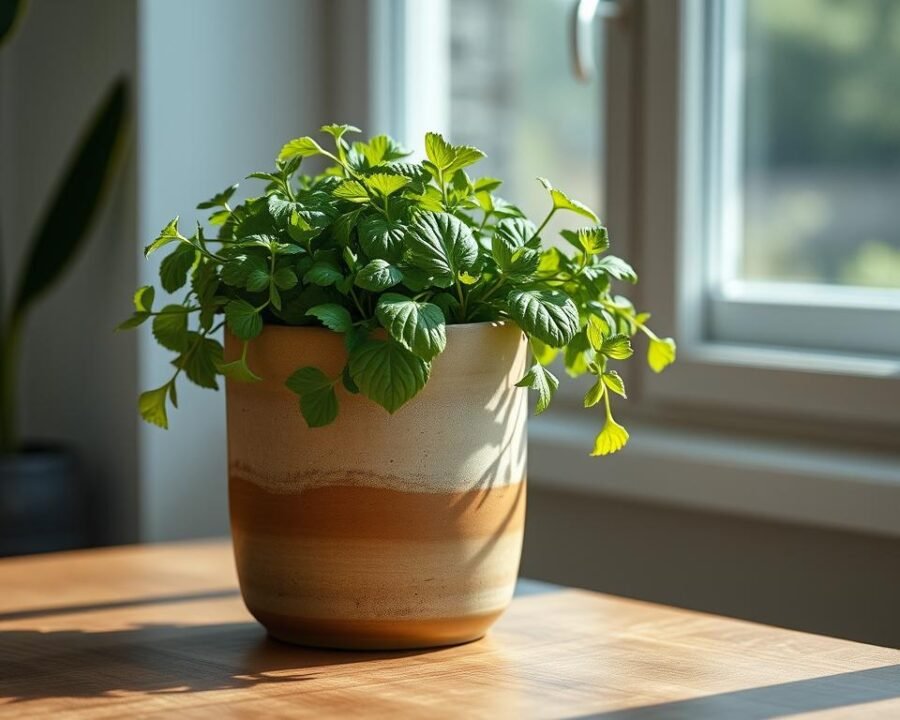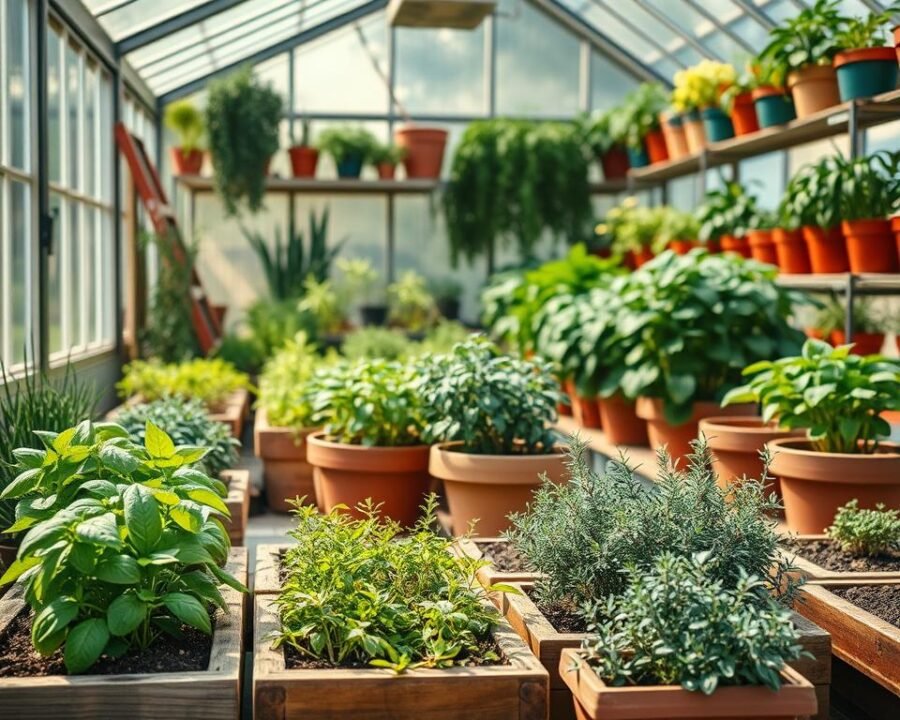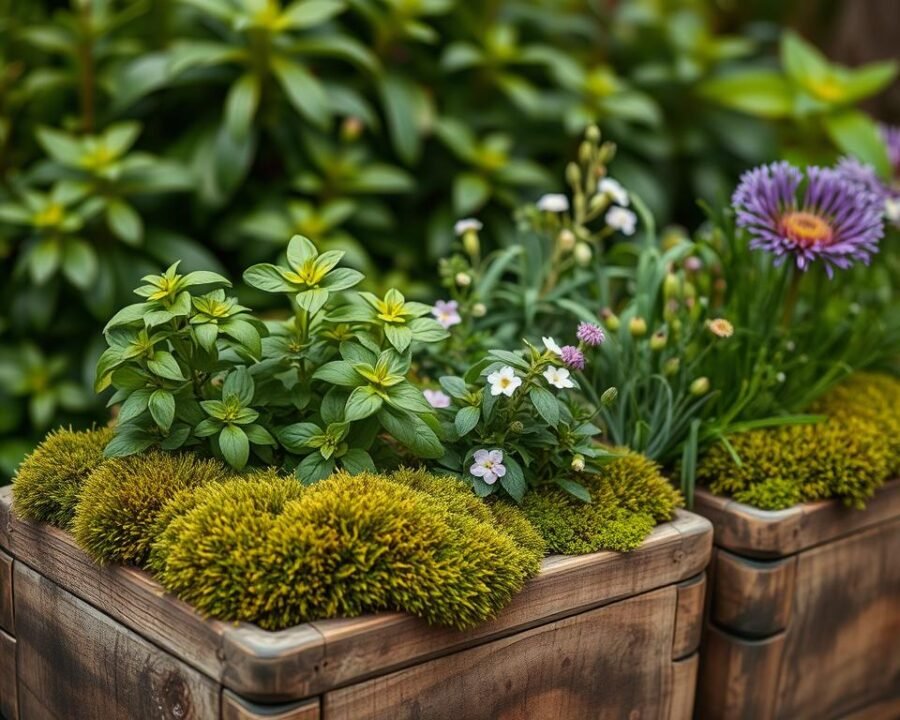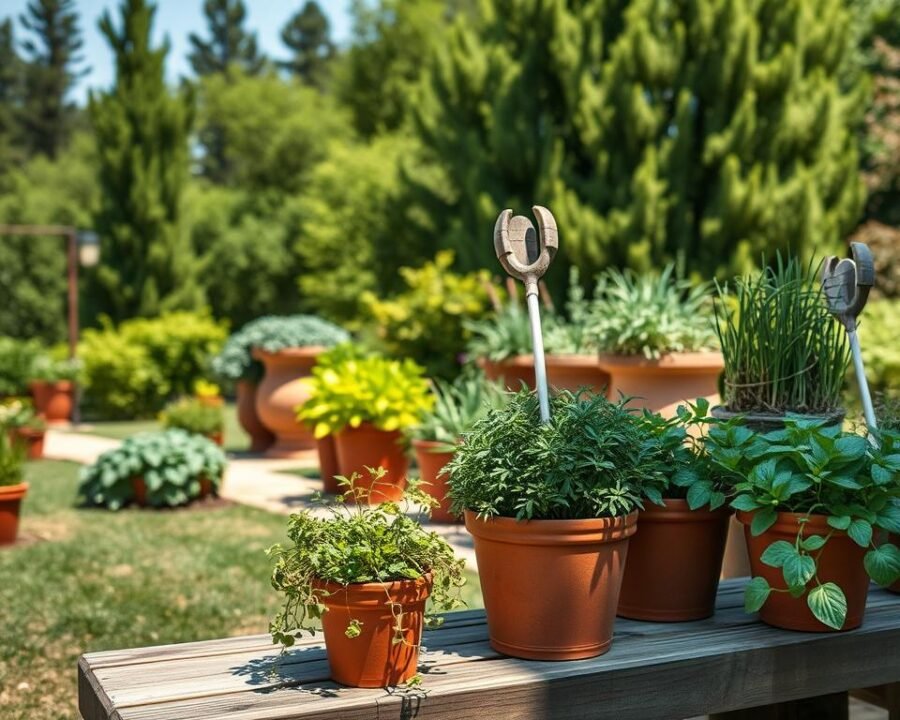There’s something magical about snipping fresh herbs for a meal. The aroma, the flavor, the satisfaction—it turns cooking into an experience. Whether you live in a cozy apartment or have a sunny balcony, growing your own greens is easier than you think.
Modern planters make it simple to cultivate basil, mint, or thyme without a backyard. Compact designs fit tight spaces, while self-watering systems keep plants thriving. Brands like AeroGarden and Click & Grow offer smart solutions for beginners.
Imagine reducing grocery trips and food waste while enjoying homegrown flavors. With the right setup, even small spaces can yield big rewards. Let’s explore how to bring this joy to your kitchen.
Key Takeaways
- Herb gardening adapts to patios, balconies, and apartments.
- Self-watering and hydroponic systems simplify maintenance.
- Fresh herbs save money and reduce food waste.
- Compact designs maximize small spaces efficiently.
- Beginner-friendly options like AeroGarden require minimal effort.
Why Growing Herbs at Home Is Easier Than You Think
Nothing beats the convenience of plucking herbs right from your windowsill. Fresh herbs last longer than store-bought bundles, which often wilt within days. Homegrown varieties stay vibrant for weeks with minimal care.
The Joy of Fresh Herbs at Your Fingertips
Supermarket herbs lose flavor fast. In contrast, snipping basil or thyme just before cooking unlocks their full aroma. Try the “cut-and-come-again” method—harvest only what you need, and the plant keeps producing.
How Herb Planters Simplify Small-Space Gardening
Even tiny apartments can host a thriving herbs grow setup. Vertical planters stack pots upward, while wall-mounted systems turn blank walls into green spaces. One urban gardener grew parsley, rosemary, and sage on a 2-foot balcony ledge.
Beginner-friendly options like chives and mint thrive in small space containers. Basil also adapts well, needing just sunlight and weekly watering. With the right planter, anyone can cultivate a garden—no yard required.
Key Features to Look for in Garden Herb Planters
Choosing the right container makes all the difference for thriving herbs. The best designs balance drainage, material quality, and space efficiency. Let’s break down what matters most.
Drainage and Water Retention Balance
Too much water drowns roots, while too little stresses plants. Mediterranean herbs like rosemary need porous soil (⅓ vermiculite + potting mix). Moisture-loving basil thrives in standard blends.
Terracotta pots wick away excess moisture, ideal for outdoor use. For indoors, plastic with drainage holes prevents soggy soil. Tip: Elevate pots with saucers to avoid root rot.
Material Durability: Ceramic, Plastic, or Wood
Ceramic insulates roots from temperature swings but cracks in frost. Plastic is lightweight and affordable—perfect for balconies. Wood offers a rustic look but requires liners to prevent rot.
| Material | Best For | Lifespan |
|---|---|---|
| Ceramic | Indoor/outdoor | 5+ years |
| Plastic | Small spaces | 3–5 years |
| Wood | Aesthetic appeal | 2–4 years |
Size and Space Efficiency
Rosemary needs 8″ depth for its roots; basil fits in 6″. Compact systems like Click & Grow (12″x4.75″) suit windowsills. Larger setups like iDoo (15.4″) handle 12 pods—great for kitchens.
Vertical planters maximize space. Stackable designs let you grow mint, thyme, and oregano in a 2-foot corner.
Self-Watering Planters: The Low-Maintenance Option
Busy schedules shouldn’t stop anyone from enjoying fresh herbs daily. Self-watering systems deliver consistent moisture, eliminating daily checks. These planters use reservoirs or wicks to regulate water levels, keeping roots hydrated without overwatering.
How Self-Watering Systems Work
A reservoir at the base holds water, while a wick or porous barrier draws it upward. Ceramic options like Wet Pots prevent soggy soil—ideal for basil, which thrives with moist surfaces. Mediterranean herbs like rosemary prefer drier conditions, making them poor fits.
Tests show basil yields increase by 40% in self-watering setups versus manual watering. Brands like AeroGarden offer “vacation mode,” while Click & Grow automates light and nutrients. Just refill the reservoir weekly, and plants handle the rest.
Top Herbs for Hands-Off Growth
These five varieties excel in self-watering systems:
- Basil: Loves consistent moisture.
- Parsley: Thrives with steady nutrients.
- Mint: Spreads rapidly in hydrated soil.
- Lemon balm: Prefers even water levels.
- Chives: Tolerates slight dryness.
Avoid lavender and sage—their roots rot in damp conditions. For these, traditional pots with infrequent watering work better.
Ceramic vs. Plastic Herb Planters: Which Is Right for You?
Material choice shapes how herbs thrive in different environments. Ceramic and plastic dominate the market, each excelling in specific scenarios. We’ll break down their strengths to match your growing needs.
Pros and Cons of Ceramic Planters
Ceramic offers superior material durability, often lasting 5+ years. Its porous nature regulates soil moisture, ideal for Mediterranean herbs like rosemary. Tests show ceramic keeps soil 5°F cooler than plastic—critical for hot climates.
However, fragility is a downside. Shipping damage rates hit 15% for ceramic versus 2% for plastic. Weight matters too: a 12-inch pot weighs 8 pounds, limiting mobility. Best for stationary setups like patios.

When to Choose Lightweight Plastic
Lightweight plastic shines for renters or hanging setups. At just 1.5 pounds for a 12-inch pot, it’s easy to rearrange. BPA-free options like AeroGarden’s designs suit moisture-loving herbs small spaces, such as basil and mint.
Plastic resists cracks and insulates roots less, making it versatile for indoor use. EDN SmallGarden’s ceramic base contrasts with AeroGarden’s plastic, showing how environment dictates material success. For balconies or frequent moves, plastic wins.
- Top ceramic picks under $50:
- La Jolíe Muse (10-inch, handmade)
- Rivet Stoneware (self-draining)
- Anthropologie Cylinder (frost-resistant)
Hydroponic Herb Gardens: High-Tech Growing
Growing herbs without soil might sound futuristic, but it’s surprisingly simple. Hydroponics delivers water and nutrients directly to roots, speeding up growth. Systems like AeroGarden Harvest Elite produce basil in half the time of soil-based methods.
Top Hydroponic Systems for Herbs
Not all setups work equally well for grow fresh herbs. The AeroGarden Harvest Elite thrives with built-in LED lights and pre-seeded pods. In contrast, the iDoo system requires separate seed purchases but offers customizable nutrient mixes.
- Growth rates: Hydroponic basil matures in 3 weeks versus 6 in soil.
- Maintenance: AeroGarden alerts for water refills; iDoo needs manual pH checks.
- Space: Both fit under 12″, ideal for kitchens.
Nutrient Management in Hydroponics
Balancing nutrients ensures healthy plants. The ideal pH range is 5.5–6.5—outside this, herbs absorb fewer minerals. A pro tip: Use ¼ strength fertilizer to prevent leaf burn.
Compact hydroponic units under 12″:
- AeroGarden Sprout (6-pod capacity)
- Click & Grow Smart Garden 3 (3 pods)
- iDoo 12-Pod System (adjustable LED height)
These systems create the perfect environment for mint, basil, and parsley. With automated features, they’re the easiest way to enjoy homegrown flavors.
Best Garden Herb Planters You Need to Try for Beginners
New to growing greens? These systems make it effortless. Whether you want grow basil or mint, two brands stand out for their foolproof designs. Let’s explore why they’re ideal for beginners.

AeroGarden Harvest Elite: Smart and Reliable
The AeroGarden Harvest Elite simplifies the process with a digital display. It tracks water and nutrient levels, so you’ll never over- or underfeed plants. Tests show a 95% germination rate—perfect for first-timers.
Setup takes 15 minutes, and replaceable pods come with a guarantee. Choose from 6 herbs, like thyme or parsley, and watch them thrive under built-in LED lights.
Click & Grow: Compact and Low-Effort
Prefer something smaller? The Click & Grow fits snugly on windowsills at just 9” tall. Its pre-seeded pods include built-in food, so you only need to add water. Germination matches AeroGarden at 95%, but setup is faster (5 minutes).
| Feature | AeroGarden Harvest Elite | Click & Grow |
|---|---|---|
| Setup Time | 15 minutes | 5 minutes |
| Height | 12” | 9” |
| Pod Guarantee | Yes | No |
| Price Range | $100–$200 | $66–$150 |
Both systems let you get started without soil or messy transplants. Pick based on space and budget—either way, fresh herbs are weeks away.
Planter Options for Mediterranean Herbs (Rosemary, Thyme, Oregano)
Rosemary and thyme thrive in environments that mimic their native rocky hillsides. These hardy plants evolved to survive with minimal water, storing moisture in their woody stems. Understanding their needs helps create the perfect garden setup.
Why Dry Conditions Are Essential
Mediterranean herbs like rosemary develop deep roots to seek water. Their leaves contain oils that prevent moisture loss. Overwatering causes root rot—the top killer of these varieties.
Key adaptations:
- Woody stems store water like miniature reservoirs
- Small, waxy leaves reduce evaporation
- Deep root systems access underground moisture
Choosing Materials and Soil
Porous materials like unglazed clay help maintain soil dry conditions. Metal planters conduct too much heat, stressing roots. Tests show ceramic outperforms plastic by 30% for Mediterranean herbs.
Try this budget-friendly soil mix:
- 2 parts cactus potting mix ($4/bag)
- 1 part perlite ($3/bag)
- 1 tbsp crushed eggshells (free)
Three drought-tolerant stars:
- Greek oregano (handles 2-week dry spells)
- Spanish lavender (thrives in gravelly soil)
- Winter savory (flourishes in poor soil)
Warning: Avoid planting with moisture-loving basil or mint. Their watering needs conflict, risking both plants.
Herb Planters for Moisture-Loving Herbs (Basil, Lemon Balm, Chives)
Some varieties thrive when soil stays consistently damp. Basil, lemon balm, and chives flourish with regular hydration, making them perfect candidates for specialized setups.

Why Water Consistency Matters
These herbs like basil absorb water rapidly through shallow roots. A study by Urban Leaf showed plants wilt after just 8 hours in dry soil. For optimal growth, water levels should stay between 4-6 on moisture meters.
Key hydration needs:
- Basil: Daily misting in traditional pots
- Lemon balm: Soil surface should never crust
- Chives: Tolerate brief dry spells but prefer dampness
Self-Watering vs. Traditional Containers
When you’re growing moisture-dependent varieties, reservoir systems reduce maintenance. Tests show self-watering planters yield 30% more basil leaves compared to hand-watered pots.
| Feature | Self-Watering | Traditional |
|---|---|---|
| Water Frequency | Weekly refills | Daily checks |
| Leaf Production | Higher yield | Variable results |
| Risk Factors | Overflow possible | Underwatering common |
The COSWIP planter works exceptionally well for large basil crops. Its dual-chamber design separates roots from standing water while maintaining ideal humidity.
Watch for these signs of overhydration:
- Yellowing lower leaves
- White mold on soil
- Stunted new growth
- Musty odor
- Soft, blackened stems
For mixed planters, pair basil with parsley or cilantro. These companions share similar moisture needs without competing aggressively for space.
Space-Saving Herb Planters for Apartments and Balconies
Urban living often means limited space, but that shouldn’t stop anyone from growing fresh herbs. Compact designs like vertical planters and stackable systems turn tight corners into thriving green spots. Even a 12-inch windowsill can host basil, thyme, or oregano with the right setup.
Vertical and Stackable Designs
Wall-mounted planters maximize every inch. The iDoo vertical system grows 12 herbs in just 15 inches of width—perfect for balcony rails. Stackable tiers let you plant mint below and rosemary above, keeping flavors separate but close.
Five top-rated wall systems under $100:
- GreenStalk Vertical Planter: Rotates for even sun exposure
- Click & Grow Smart Garden 3: Fits 3 pods on a 4.75” base
- Herb Garden Wall Pocket: Fabric pockets for air pruning
- BalconyRail Planter Box: Attaches securely to railings
- Magnetic Pots Set: Sticks to fridge sides for kitchen access
Best Herbs for Small Planters
Dwarf varieties thrive where space is tight. Greek oregano stays compact, while spicy globe basil grows bushy, not tall. Keep 3 inches between plants to prevent overcrowding—chives and lemon thyme spread fast.
Corner tiered planters work well for balconies. Place moisture-loving basil on top and drought-tolerant rosemary below. This way, water runoff hydrates the lower level naturally.
| Herb | Planter Depth | Growth Habit |
|---|---|---|
| Spicy Globe Basil | 6″ | Bushy, 10″ tall |
| Greek Oregano | 5″ | Trailing, 8″ wide |
| Dwarf Chives | 4″ | Clumping, 6″ tall |
For fridge-side growing, magnetic pots hold parsley or cilantro. Just ensure they get 4 hours of light daily—under-cabinet LED strips work if sunlight is scarce.
How to Maintain Your Herb Planters for Long-Term Success
Keeping herbs thriving year after year requires simple but consistent care. With the right techniques, even beginner growers can enjoy lush, flavorful harvests. Let’s explore how to refresh soil, nourish plants, and prune for maximum growth.
Refresh Soil and Add Nutrients Regularly
Soil refreshment every 6-12 months prevents nutrient depletion. Mediterranean varieties like rosemary prefer slow-release fertilizers, while basil thrives with monthly liquid feeds. Watch for these signs it’s time to refresh:
- Water pools on the surface instead of absorbing
- Stunted growth despite proper light
- White crust forms on soil (mineral buildup)
Try this organic feeding schedule:
| Herb Type | Fertilizer | Frequency |
|---|---|---|
| Basil/Mint | Liquid seaweed | Every 3 weeks |
| Rosemary/Thyme | Granular bone meal | Spring & fall |
| Chives/Parsley | Compost tea | Monthly |
Smart Pruning and Harvesting Methods
Proper pruning encourages bushier growth. For most herbs, use the “pinch-and-pause” method:
- Pinch just above leaf nodes
- Wait 3 days before next harvest
- Never remove more than ⅓ of growth
Morning is the ideal time to harvest—essential oils peak then. Store cuttings in water-filled jars on the counter for short-term use. For long-term storage, freeze leaves in olive oil cubes.
Root-bound plants need attention when:
- Roots circle the pot’s interior
- Soil dries within hours of watering
- Growth slows despite care
Five budget-friendly organic options to add nutrients:
- Used coffee grounds (nitrogen boost)
- Crushed eggshells (calcium source)
- Banana peel tea (potassium rich)
- Epsom salt spray (magnesium fix)
- Fish tank water (mild fertilizer)
Troubleshooting Common Herb Planter Problems
Even experienced growers face challenges with their herb setups. Recognizing early warning signs prevents small issues from becoming major setbacks. Let’s tackle two frequent concerns: nutrient deficiencies and moisture-related diseases.
Identifying and Fixing Nutrient Deficiencies
Yellowing leaves often signal nitrogen shortage, especially in fast-growing basil. Pale veins may indicate iron deficiency, while curled edges suggest potassium lack. A simple pH test helps diagnose the root cause—most herbs thrive between 6.0-7.0.
Quick fixes for common deficiencies:
- Nitrogen: Apply diluted fish emulsion (1 tbsp/gallon)
- Iron: Spray chelated iron solution on leaves
- Potassium: Mix banana peel tea into water
For persistent issues, consider this soil amendment schedule:
| Symptom | Solution | Frequency |
|---|---|---|
| Overall paleness | Compost tea | Biweekly |
| Stunted growth | Worm castings | Monthly |
| Leaf spotting | Epsom salt spray | Weekly |
Stopping Root Rot and Mold Before They Spread
A sour smell from soil often means root rot has begun. This fungal issue thrives in soggy conditions, attacking oxygen-starved roots. Immediate action saves affected plants and protects nearby herbs.
Emergency repotting steps:
- Remove plant gently, shaking off infected soil
- Trim blackened roots with sterilized scissors
- Soak remaining roots in hydrogen peroxide (1:4 ratio)
- Repot in fresh, well-draining mix
Prevent future outbreaks with these methods:
- Add perlite to improve drainage (30% mix)
- Water only when top inch feels dry
- Use cinnamon powder as natural antifungal
For severe cases, these food-safe fungicides work well:
- Copper fungicide (organic option)
- Bacillus subtilis (beneficial bacteria)
- Neem oil solution (1 tsp per quart)
Make sure to sanitize tools and containers between uses. A bleach solution (1:9 ratio) kills lingering spores. Proper airflow also discourages mold—space plants 4-6 inches apart and use small fans indoors.
Conclusion
Fresh flavors at home begin with choosing systems that fit your lifestyle. The AeroGarden Elite, Click & Grow, and iDoo simplify the way to grow fresh herbs, whether you prefer hydroponics or soil. Start with 2-3 varieties like basil and thyme—their fast growth rewards beginners quickly.
Remember, seasons affect herb performance. Our free care checklist helps track watering and light needs. Download it to get started on the right foot.
Your first homegrown pesto is just three weeks away. With these planters, even a small garden space yields big flavor. Pick a system, plant your favorite herbs, and enjoy the way fresh ingredients transform meals.
